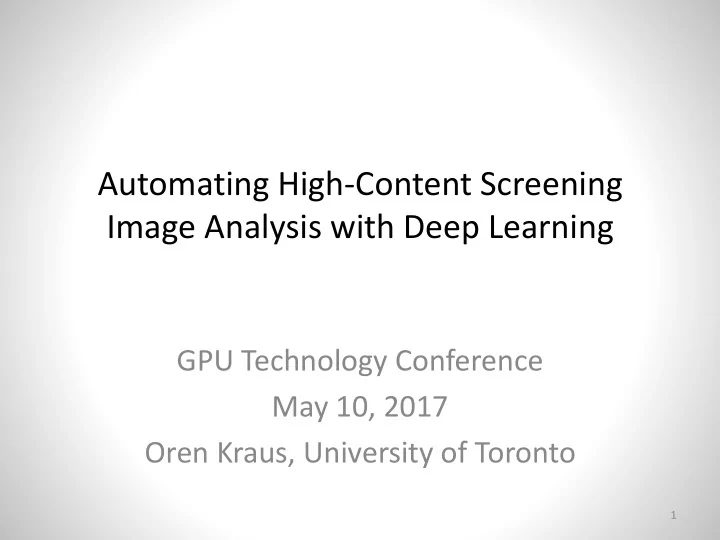

Automating High-Content Screening Image Analysis with Deep Learning GPU Technology Conference May 10, 2017 Oren Kraus, University of Toronto 1
High-Content Screening (HCS) Arrayed chemical or Automated Cellular genetic conditions microscopy phenotypes 2
Applications Image based drug profiling Functional genomics (Chong, 2015) (Gustafsdottir, 2013) 3
Why HCS? Phenotype Fitness Morphology Wild-type spindle Growth defect Cellular fitness as colony size (Costanzo, 2016) Fish hook spindle (mcm21 ∆ ) (Vizeacoumar, 2010) 4
Previous approaches Classifying Measuring specific images by eye parameters (Zanella, 2007) (Breker, 2013) (Singh, 2014) Previous implementations of HCS relied on manual inspection of each image or extracting specific measurements for a particular study 5
Phenotypic profiling Single cell segmentation Feature extraction Phenotypic profiles & selection Clustering & visualization Classification Phenotypic profiling is used to construct quantitative and unbiased representations of single cells for classification or clustering 6 (Kraus, 2016)
Complexity of profiling pipelines • Imaging protocol needs to be optimized together with analysis pipelines • Segmentation needs to be tuned for every screen • Feature extraction & selection needs to be optimized for every task • Machine learning algorithm needs to be tuned for every task • Analysis pipelines are not transferable across screens (Boutros, 2015) 7
Deep learning ‘ solves’ object recognition (Kraus, 2016) (Russakovsky, 2015) Deep learning has significantly outperformed feature extraction based classifiers on the popular ILSVRC image recognition benchmark since 2012 8
Deep learning basics Nuclear periphery Prediction compared to label Updated during Updated during training training 9 (Kraus, 2017)
Deep learning features 10 (Kraus, 2016)
Quantifying proteome dynamics with HCS Fluorescently tagged strain generation Protein sub-cellular compartment localizations Localization changes in response to RPD3 genetic deletion 11 (Chong, 2015)
Ensemble of 60 binary SVMs (EnsLoc) 12 (Chong, 2015)
DeepLoc: Classifying protein localization with deep learning Output Input Convolutional Block Max Fully Pooling Connected Non-Linear Convolution Layers Activation DeepLoc is a deep convolutional neural network consisting of 11 layers and is trained to classify images of single cells into 17 localization categories 13 (Kraus, 2017)
DeepLoc classification performance DeepLoc significantly outperforms ensLoc at single cell protein localization and at annotating the localization of proteins 14 (Kraus, 2017)
DeepLoc features DeepLoc DeepLoc EnsLoc The single cell profiles learned by DeepLoc are better at representing cell images compared to extracted features 15 (Kraus, 2017)
How DeepLoc works = * Convolutional Filter Visualizations (Layer 8) Input Samples Layer 8 Activations Features in DeepLoc are activated when a learned pattern matches the input image 16 (Kraus, 2017)
Discovering proteins involved in mating Abundance Log2 Change Fdo1 Kss1 Mcd1 Yor342c Prm1 Prm2 Fus1 Nvj1 Bfa1 Untreated Factor Treated Group 1 Group 2 Group 3 17 (Kraus, 2017)
Using DeepLoc on other images Actin Bud Neck Bud Site Bud Tip Eisosomes Endosome ER Golgi Chong 2015 Labels New Labels 18 (Kraus, 2017)
Transfer learning with DeepLoc Using only 5 labeled samples per class, DeepLoc can be fine-tuned to accurately assess protein localization for most categories 19 (Kraus, 2017)
Deep learning automates HCS analysis Deep learning automates the analysis of microscopy images by combining the steps in previous pipelines into one transferable model 20 (Kraus, 2017)
Acknowledgments Boone and Andrews Labs (Ben Grys) Frey Lab (Jimmy Ba) Jimmy 21
Deep Learning High Content Discovery & Screening Diagnostics www.phenomicai.com 22
Recommend
More recommend